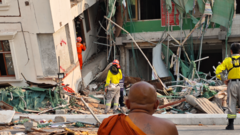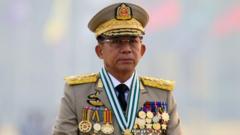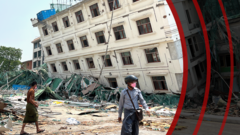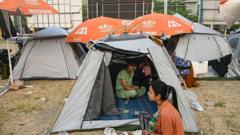Fighting continues in Myanmar even after a temporary ceasefire was declared by military and rebel groups to facilitate earthquake recovery efforts, with a significant death toll from the disaster.
Ongoing Strife in Myanmar Amid Earthquake Relief Efforts
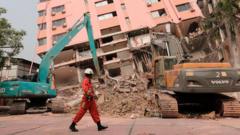
Ongoing Strife in Myanmar Amid Earthquake Relief Efforts
Despite ceasefires announced for earthquake relief, fighting persists in Myanmar.
In Myanmar, unrest continues unabated as reports indicate ongoing clashes, even after the military junta and an alliance of rebel groups declared temporary ceasefires aimed at facilitating relief efforts following a devastating earthquake. The military has reportedly engaged in at least 14 attacks since the ceasefire was announced, as confirmed by the UN Human Rights office.
The military has accused two of the rebel groups involved in the ceasefire of initiating violence. One of the groups claimed that hostilities erupted as a reaction to military offensives. Maj Gen Zaw Min Tun, a spokesperson for the military council, asserted that they would retaliate if military installations were attacked unjustifiably. No comments from the army were received by BBC Burmese regarding the escalated tensions.
UN High Commissioner for Human Rights, Volker Türk, has implored all military operations to cease, emphasizing the need to aid those impacted by the 7.7 magnitude earthquake that struck on March 28. Ongoing civil strife between the junta, which assumed control in a coup in 2021, and various ethnic militias and resistance groups complicate the situation.
Following the earthquake, the military announced a ceasefire effective from April 2, which coincided with an earlier declaration from the rebel coalition comprising three groups. The official death toll from the quake has escalated to 3,564, with 5,012 injuries reported and over 210 individuals still unaccounted for.
Search and rescue operations in Mandalay are fervent as workers sift through the debris of dilapidated buildings. Rainfall over the weekend may further complicate relief initiatives. The UN Human Rights office has acknowledged improvements in humanitarian access where allowed, yet hindrances imposed by the military have left many severely affected regions inaccessible to outside aid—but residents are managing local assistance.
UN humanitarian chief Tom Fletcher, speaking from Mandalay, reported dire needs among the populace for food, water, and electricity restoration, along with shelter provisions. Continued aftershocks, including a recent 4.9 magnitude tremor, add to the psychological trauma endured by communities already in crisis before the earthquake. With almost 20 million people in need prior to the disaster, Fletcher categorized the situation as a multilayered crisis: an earthquake compounded by ongoing conflict and pre-existing humanitarian needs.
The military has accused two of the rebel groups involved in the ceasefire of initiating violence. One of the groups claimed that hostilities erupted as a reaction to military offensives. Maj Gen Zaw Min Tun, a spokesperson for the military council, asserted that they would retaliate if military installations were attacked unjustifiably. No comments from the army were received by BBC Burmese regarding the escalated tensions.
UN High Commissioner for Human Rights, Volker Türk, has implored all military operations to cease, emphasizing the need to aid those impacted by the 7.7 magnitude earthquake that struck on March 28. Ongoing civil strife between the junta, which assumed control in a coup in 2021, and various ethnic militias and resistance groups complicate the situation.
Following the earthquake, the military announced a ceasefire effective from April 2, which coincided with an earlier declaration from the rebel coalition comprising three groups. The official death toll from the quake has escalated to 3,564, with 5,012 injuries reported and over 210 individuals still unaccounted for.
Search and rescue operations in Mandalay are fervent as workers sift through the debris of dilapidated buildings. Rainfall over the weekend may further complicate relief initiatives. The UN Human Rights office has acknowledged improvements in humanitarian access where allowed, yet hindrances imposed by the military have left many severely affected regions inaccessible to outside aid—but residents are managing local assistance.
UN humanitarian chief Tom Fletcher, speaking from Mandalay, reported dire needs among the populace for food, water, and electricity restoration, along with shelter provisions. Continued aftershocks, including a recent 4.9 magnitude tremor, add to the psychological trauma endured by communities already in crisis before the earthquake. With almost 20 million people in need prior to the disaster, Fletcher categorized the situation as a multilayered crisis: an earthquake compounded by ongoing conflict and pre-existing humanitarian needs.






